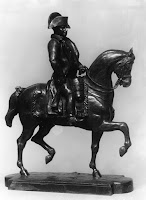Salvete omnes,
I do little fencing, well sort of, - mostly with my son, who has had several years of
fencing, including 2 years in Colorado with
Maciej Czyzowicz.
We use and practice with the
palcaty-sabres from a
GoNow, there is always lots of fun and plenty of exercise -
video example of these
palcaty-sabres in action.
 |
| Palcaty dueling by young noble boys in the Field of Wola, detail of the AD1697 painting |
In the XVII and XVIII centuries
Palcaty or wooden stick fighting was the favorite pastime, while sword training, of the Polish nobility young sons and schoolboys in Rzeczpospolita (Commonwealth), and according to our XVIII century historian and diarist father Jedrzej Kitowicz students at the
Piarists and
Jesuit schools practiced this art in schools, often before a class started, often the younger professors and older students who being masters themselves were also teaching the art to the younger ones, while the student who was too timid and too afraid to practice
palcaty and duel with them was bullied and had to withstand many insults from the entire school:
Drugą zabawą podczas rekreacyi były kije, zwane palcatami, w które
pojedynkowali studenci dwaj a dwaj z sobą. Ten sposób wielce był
potrzebny dla stanu osobliwie szlacheckiego, jako wprawiający młódź do
zręcznego w swoim czasie użycia szabli, którą nasi przodkowie na wojnach
najwięcéj dokazywali. Jakoż było się czemu przypatrzyć, kiedy się dwaj
dobrali do palcatów, bili się aż do zmordowania, a tak sztucznie każdy
się palcatem swoim układał zastawiając się ze wszelkich
stron, a oraz wzajemnie adwersarza swoim przycięciem sięgając, że żaden
żadnego ani w gębę, ani w głowę, ani po bokach nie mógł dosiągnąć.
I
tacy byli to już jak metrowie do wprawiania i uczenia drugich. Co się
trafiało i między professorami młodszemi, tak Jezuitami jak Pijarami, że
się w kije arcyprzednio bili. Te tedy palcaty u studentów były w
najczęstszym używaniu, nie tylko na rekreacyach, ale nawet i w samych
szkołach, nim nastąpiła godzina lekcyi. Jeżeli był który student
bojaźliwy, że nieśmiał z drugim stanąć do palcata; musiał taki wiele
wycierpieć prześladowania, i urągania od całéj szkoły.
Kajetan Kozmian, in his
Diaries, wrote that
palcaty were perhaps more honorable form of fighting amongst the young, instead of the vulgar fist-fighting, but many boys received black and blues and bloody noses after
palcaty duel; while the masters of
palcaty could have become bullies and rouges etc
, eventually could became problem makers at the sejmiki(county diets) and other public gatherings
, thus making a living from swordfighting for hire
.
Adam Mickiewicz in
Pan Tadeusz, Book II, wrote about
palcaty training for the youth
Henryk Rzewuski, in his
Pamiatki Soplicy, wrote that it was the
Jesuits who promoted
palcaty drills in their schools as
one of the games suitable to the Polish tastes and spirit
.
Henryk Sienkiewicz put
palcaty drills in this
Trilogy, eg Jan Skrzetuski practiced palcaty drills with pan Michal Wolodyjowski in
With Fire and Sword.
Palcaty stayed popular as Polish schoolboys and university students sport until the tragedy of World War II. The Communists did not revive this art after the Holocaust.
Presently Signum Polonicum fencing & reenactment group has been doing work to revive Old Polish fencing, including
palcaty drills, and they have a book and
videos about the Old Polish fencing, including
palcaty -
here more info.
Blood and Iron HEMA group put a
video up showing an example of the Palcaty game.
Julian Maszynski painting from the XIX century
so not only kendo is out there for you to practice - :)
enjoy



















































